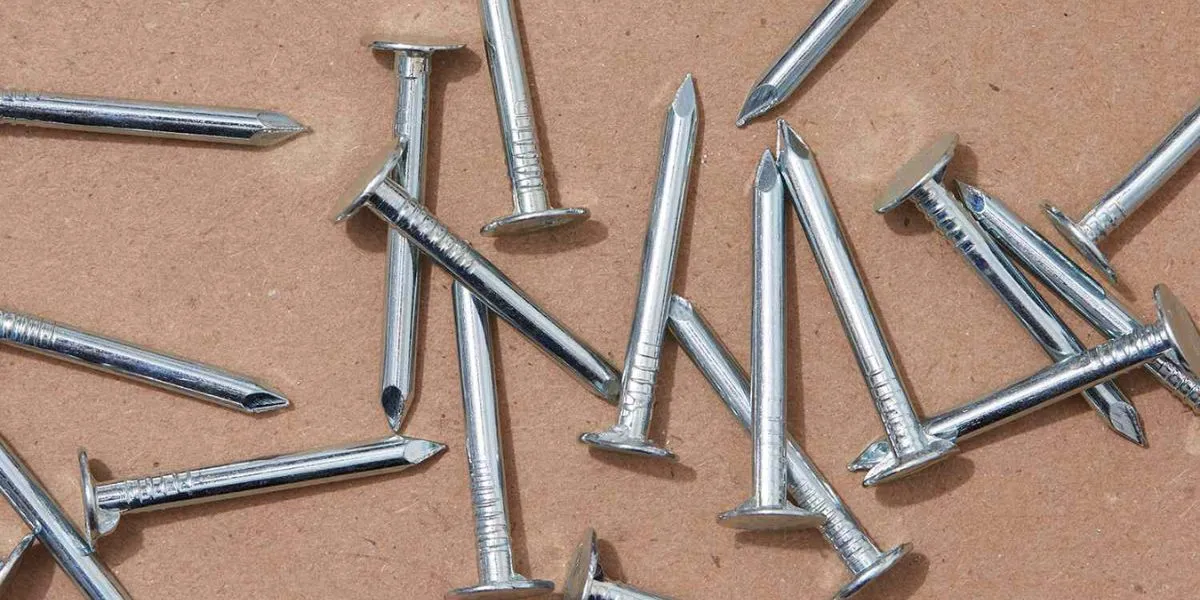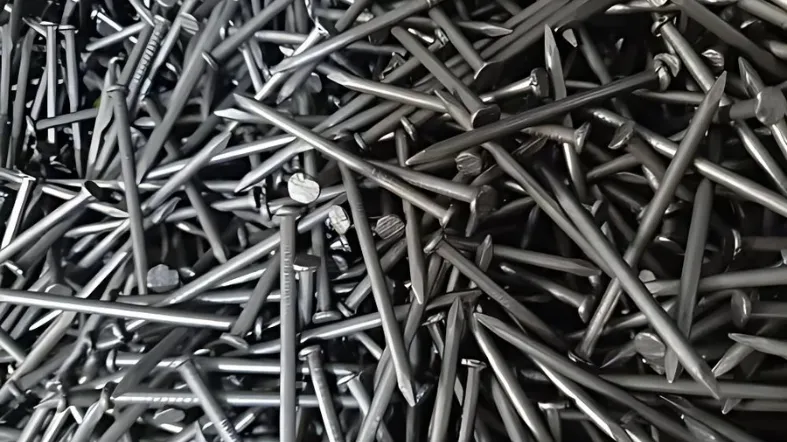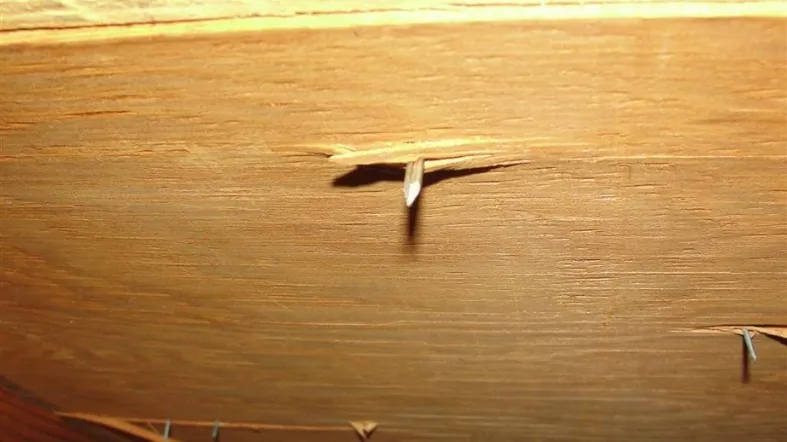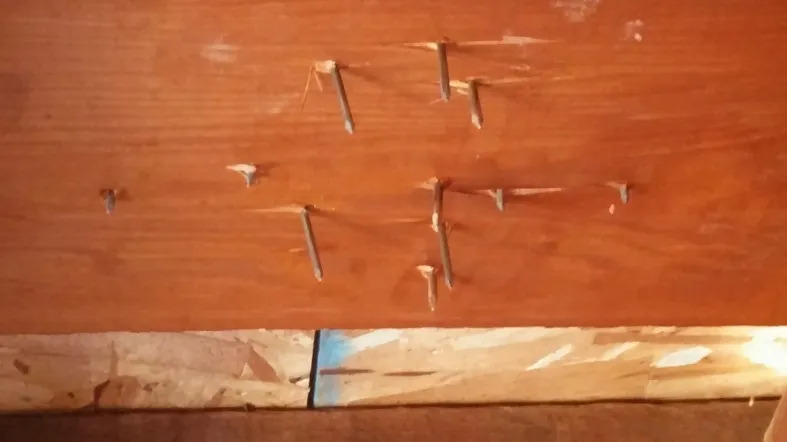Are you gearing up for a roofing project and wondering what size roofing nails for 1/2 plywood? Choosing the right nail size is more critical than you might think.
Using the wrong size can lead to a host of problems, from loose shingles to water damage and even roof collapse!
In this blog, we’ll guide you through the maze of nail sizes, helping you make an informed decision that will keep your roof sturdy and secure for years to come.

What Size Roofing Nails for 1/2 Plywood?
For securing 1/2-inch plywood to roof rafters, 1-1/2 to 2-inch galvanized roofing nails are typically used. The nail should penetrate at least 3/4 inch into the rafter. Using shorter nails may compromise the plywood’s stability, while longer nails could puncture through the roofing material.
Roofing Nails Size for 1/2 Plywood:
| Nail Size | Penetration into Rafter | Suitability for 1/2-inch Plywood |
|---|---|---|
| 1 inch | Less than 3/4 inch | Too short for effective hold |
| 1-1/2 inch | At least 3/4 inch | Meets minimum penetration requirements |
| 2 inch | 1-1/4 inches | Offers extra stability |
| 2-1/2 inch | Over 1-1/4 inches | Might be too long and risk puncturing other materials |
Types of Roofing Nails Suitable for 1/2 Plywood
Galvanized Roofing Nails
Galvanized roofing nails are a popular choice for many homeowners and contractors. They are made of steel and coated with a layer of zinc.
This zinc coating acts as a barrier that protects the steel from rust and corrosion. When you’re installing 1/2 plywood, these nails can provide excellent durability and longevity.
Remember, though, that while galvanized nails are rust-resistant, they’re not entirely rust-proof. If you live in a coastal area with salty air, you might want to consider a different type of nail.
Aluminum Roofing Nails
Aluminum roofing nails are lightweight and resistant to corrosion, which makes them another good option for roofing.
They’re especially suitable for aluminum roofing or siding where you want the nails to match the material.
However, aluminum isn’t as strong as other metals, so these nails might not be the best choice if your roof needs to withstand heavy loads or high winds.
Stainless Steel Roofing Nails
If strength and corrosion resistance are your top priorities, stainless steel roofing nails might be your best bet.
These nails are made from an alloy that includes steel and at least 10.5% chromium, which makes them highly resistant to rust.
They’re a bit more expensive than galvanized or aluminum nails, but they can be worth the cost if you live in a harsh climate or want your roof to last as long as possible.
Copper Roofing Nails
Copper roofing nails are often used for traditional or historic buildings. They’re highly resistant to corrosion and provide a beautiful, natural finish that can enhance the appearance of your roof.
However, copper nails are more expensive than other types and can be harder to find. If you’re considering copper nails for your project, make sure to budget accordingly.
Why Choosing the Right Nail Size is Important?

Structural Integrity
The right nail size is crucial for the structural integrity of your roof. When you use the correct size, the nails will securely fasten the plywood, providing a solid and sturdy base for your roof.
This means your roof will be more stable and less likely to suffer damage.
Weather Resistance
Nails that are the right size can better withstand harsh weather conditions. Whether it’s heavy rain, strong winds, or snow, properly sized-nails will keep your roof secure and prevent damage.
This is because they penetrate deep enough into the plywood and roofing material to create a strong bond.
Aesthetic Appeal
Believe it or not, the size of the nails you use can affect the overall look of your roof.
Nails that are too large can stick out and look unsightly, while nails that are too small may not hold the roofing material properly, leading to uneven surfaces.
So, choosing the right nail size helps maintain the aesthetic appeal of your roof.
Cost-Efficiency
Lastly, choosing the right nail size can save you money in the long run. Using the correct size means fewer repairs or replacements in the future.
It also means less wasted material if you don’t have to remove and replace nails that are the wrong size.
So, while it might seem like a small detail, choosing the right nail size is an important part of cost-efficient roofing.
Factors Influencing the Choice of Nail Size

Plywood Thickness
The thickness of your plywood is a key factor in choosing the right nail size. Thicker plywood requires longer nails to ensure a secure fit. For 1/2-inch plywood, nails that are 1-3/4 inch to 2 inches long are typically suitable.
Roof Material
The type of roofing material you’re using can also influence the nail size. Some materials, like asphalt shingles, might require shorter nails, while others, like wood shakes, might need longer ones.
Climate and Weather Conditions
If you live in an area with high winds or heavy snowfall, you might need to use longer nails to provide added security and prevent your roofing material from being blown off or damaged.
Building Codes and Regulations
Always check your local building codes before starting your roofing project. These codes may specify certain nail sizes or types that you need to use to ensure your roof is safe and up to standard.
Installation Method
The method you use to install your roof can also affect the nail size. For example, if you’re using a nail gun, you might need to use shorter nails to prevent them from penetrating too deeply into the plywood.
Budget Constraints
Your budget can also influence your choice of nail size. While it’s important to choose the right size for the job, you also need to consider the cost of the nails and choose a size that fits within your budget.
Durability and Longevity
Choosing the right nail size can help increase the lifespan of your roof.
Nails that are too short may not hold the roofing material securely over time, while nails that are too long can cause damage to the plywood or roofing material.
Common Mistakes to Avoid When Nailing 1/2 Plywood
Using the Wrong Nail Size
One of the most common mistakes is using nails that are either too short or too long. This can lead to structural issues or aesthetic problems.
For 1/2 plywood, nails that are 1-3/4 inch to 2 inches long are typically suitable.
Incorrect Nailing Technique
Another mistake is not driving the nails straight or flush with the surface of the plywood. Nails should be driven straight into the plywood to ensure a secure fit.
If they’re driven at an angle, it can weaken the hold and lead to instability.
Ignoring Local Building Codes
It’s important to always check local building codes before starting your roofing project.
These codes may specify certain nail sizes or types that you need to use. Ignoring these codes can lead to safety issues and may even result in fines or penalties.
Overdriving or Underdriving the Nails
Finally, avoid overdriving or underdriving the nails. Nails should be driven just below the surface of the plywood, not too deep or too shallow.
Overdriven nails can damage the plywood, while underdriven nails may not hold the roofing material securely.
How to Properly Install Roofing Nails on 1/2 Plywood

Choose the Right Type of Roofing Nails
First, you have to pick the right type of roofing nails for your project. They usually come in different materials like aluminum, copper, and galvanized steel.
Use galvanized steel nails for most types of shingles because they resist rust. Pick nails that are at least 1 1/2 inches long to make sure they grip well into the plywood.
If you’re using asphalt shingles, galvanized steel nails are a great choice. They’re strong and won’t rust easily.
Gather Your Tools
You’re going to need a few important tools to do this job right. Get a roofing nail gun or a hammer, a ladder, safety goggles, and gloves. Put all your tools in a tool belt so you don’t have to climb up and down the ladder.
You can find a tool belt at a hardware store. It wraps around your waist and holds your tools in little pouches.
Position the Ladder Safely
Safety first! Place your ladder on solid, flat ground. Make sure it’s angled so for every four feet of height, the base is one foot away from the wall. This keeps you safe while climbing up and down.
If your roof is 12 feet high, the bottom of your ladder should be 3 feet away from the wall.
Use a Chalk Line for Guidance
Before you start nailing, use a chalk line to mark where the nails will go.
Snap a straight line across the plywood so you know exactly where to place each nail. The lines help you keep things neat and tidy.
Nail Placement and Spacing
The spacing between each nail matters a lot. Start nailing at one corner of the plywood and move across, following your chalk line.
Place nails 6 inches apart along the edges and 12 inches apart in the middle areas.
Correctly Angle Your Nails
When using a roofing nail gun or hammer, aim it at a slight downward angle. This ensures the nail goes in securely and holds the shingles tight. Make sure each nail goes in straight without bending.
Check Your Work
After you finish nailing, double-check to make sure all nails are flush against the plywood and shingles.
They shouldn’t stick up or be too deep into the plywood. If you find any that aren’t perfect, fix them right away.
Safety Tips While Working
Never forget about safety. Always wear your safety goggles and gloves. Don’t lean too far over the edge of the roof, and always make sure someone knows you’re working up there.
FAQs
Can I use 1-inch nails for 1/2-inch plywood roofing?
Is it okay to use aluminum nails for a roof that has to withstand heavy loads?
Are copper nails suitable for modern roofs?
Does the angle at which the nail is driven matter?
Are galvanized nails completely rust-proof?
Conclusion
Choosing the right size roofing nails for 1/2 plywood is crucial for both aesthetic appeal and structural integrity.
By considering factors such as plywood thickness, roof material, and local building codes, you can make an informed decision that will benefit your project in the long run.
